► The Reliant that became a Volvo that became a Citroen
► Why we love the Citroen BX
► Gandini’s hatchback driven
Supercars don’t come any more iconic than the Lamborghini Countach, but when’s the last time you actually saw one in person? Possibly never, not something you could have said of another wedge of Gandini design, the Citroen BX.
Those who lived in Europe during the 80s and 90s will be very familiar with this angular, hydropneumatically-sprung five-door hatchback and estate. Although it’s a car we once took for granted, there are now just 213 on the road at the time of writing. It’s an interesting car with a convoluted development that’s a story worth telling. After all, not only is the story entwined with that of the Lamborghini Countach, but it also involves Peugeot, Volvo and even purveyors of fibreglass oddities Reliant.
With that in mind, let’s not start with the BX’s launch on 30th September 1982 at the Paris Motorshow, or its first public airing at the Eiffel Tower seven days earlier, and instead go back a further five years to the long-forgotten Reliant FW11 prototype of 1977. In between building economy-minded three-wheeler economy cars such as the Robin and Regal, and upwardly mobile coupes and shooting brake Scimitars, Reliant could be found engineering rugged family transport for developing markets such as the Anadol for Turkey.
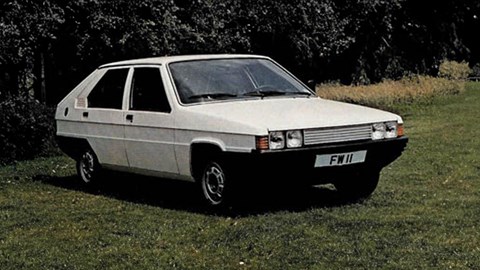
With their relative success locally, thoughts turned to a more stylish and upmarket five-door that combined a simple ladder-frame chassis, reliable four-cylinder engines and a familiar rear-drive layout. To make the new car stand out, Bertone were tasked with designing a rakish fastback bodystyle complete with a new-fangled hatchback for ease of loading. After all, if it was good enough for the luxurious Rover SD1, it was good enough for the FW11.
Marcello Gandini was told to break out the magic markers and get to work, the resultant angular design showing more than a few hints of Alfa Carabo, Ferrari Rainbow, and of course the Countach. Naturally the dramatic mid-engined proportions of his more exotic efforts couldn’t be replicated, but the clean lines, angular wheelarches and avoidance of curves were all Gandini hallmarks.
Ultimately Anadol rejected the proposal as no profit was seen in such a ‘high-end’ car with such bougie luxuries as – shock – electric windows in their home market. Even so, a few prototypes were built including one badged as a Reliant Scimitar SE7, a tantalising glimpse into what could have come after the William Towns designed Scimitar GTE shooting brake.
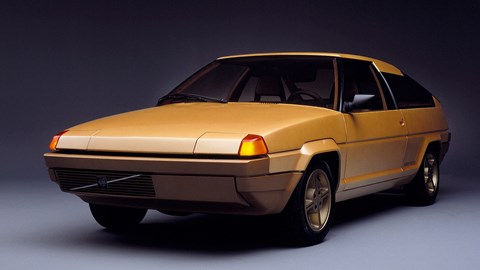
Gandini was clearly fond of the design as a refined version surfaced a mere two years later as the Volvo Tundra. Now sporting three instead of five doors, pop-up headlights and unusual clear plastic panels in its wide, flat C-pillars, it was based on the exceptionally dowdy Volvo 343, a car that’s only interesting feature was a transaxle gearbox a-la Porsche 928.
As much as an advert for Bertone’s services as a design proposal for Volvo, the Tundra upped the glam substantially from the FW11. Gone were the tiny steel wheels, easy to produce single-piece fibreglass bodyshell and conventional interior, replaced with glitzy alloys, a more conventional multi-piece body and an LCD instrument cluster for the driver.
Once again, this was something of a dead end for Gandini’s penmanship, Volvo unsurprisingly finding it too much of a departure from its dependable if dull image at the time. That’s not to say Volvo didn’t let Bertone loose(ish), after all the 780 Coupe was designed and built by the Italian Carrozzeria, showing what the Swedes considered a daring design for the mid-eighties.
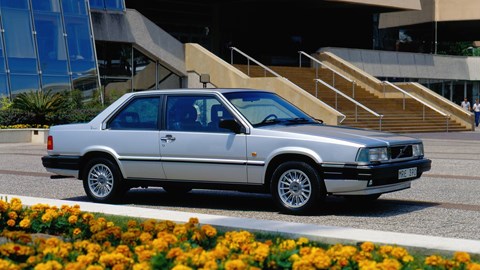
Who knows what might have happened should the green light have been given for the Tundra, although perhaps we shouldn’t be surprised that Volvo’s own compact 480 arrived shortly after the 780 complete with pop-up lights, hatchback rear and shrunken, low-mounted Volvo grille all featured in Gandini’s design.
With the eighties incoming and aerodynamics becoming the buzzword, you might have expected Gandini to give up on his vision of a hatchback. Thankfully for him it was third time lucky, with Citroen now looking for a mass-market friendly replacement for the rapidly aging GSA, itself based on 1970’s GS.
Where the GS was a pure Citroen, albeit one heavily influenced by Pininfarina’s BMC 1800 Berlina Aerodinamica, its replacement would be the fruit of a buyout by long-term rival Peugeot. After Citroen had gone bankrupt overstretching itself with unreliable rotary engines and similarly troublesome ownership of Maserati, the GSA replacement was to share a platform and engines with an upcoming Peugeot saloon, the 405.
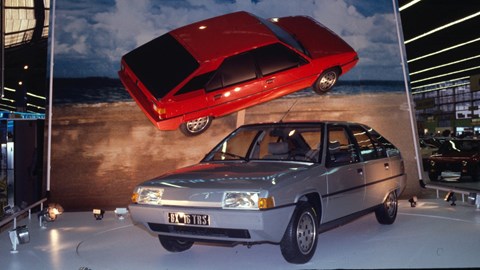
However, nobody at Citroen wanted to just restyle a Peugeot and stick a double chevron on it. Project XB would take that Peugeot supplied platform and add just enough weirdness for it to be a ‘proper’ Citroen, not that the diehards thought so at the time. So, out went the conventional steel springs in favour of self-levelling and height adjustable suspension made famous by the DS, you’d load your luggage via a practical hatch instead of an old-fashioned boot lid, and conventional instruments would be replaced by Citroen’s rotating bathroom scales.
Still, Citroen knew it had to appease its Peugeot overlords, with Project XB designed to be far easier and therefore cheaper to maintain than the GSA. Efficiency was also crucial, with fuel-sipping diesel engines and a sub-1000kg weight courtesy of plastic panels, while space inside was generous for its footprint. What better way to clothe everything than Gandini’s third bite of the big hatchback apple?
While it’s lovely to have a potted history, what’s the car like today? First, a small admission; your writer has something of a history with the BX having done much growing up in them. I’ve experienced fairly basic 1.6s, a turbodiesel, 8v GTi and even a 4×4, while a long-time family friend owned a 16v and knew how to wring the best from it.

Even so, my experience driving one boils down to a brief bit of kangarooing around a Welsh carpark before I was old enough to legally drive. So, it’s with huge reserves of excitement and some trepidation that I get behind the wheel of an exceptionally tidy 1.6-litre Athena from late in the BX’s production run.
Opening the flimsy door awakens all sorts of memories, with the smell of old French car taking me back over 25 years. Sinking into the soft seats confirms they’re as comfy as I remember, with the carburettor-fed four-pot not liking a hot start just like my mum’s 16 RS. As I slot first gear in the baggy ‘box (they’re all like that, sir) I remind myself that I should stay objective, something made much harder by the surprisingly willing engine. Aiming it down a reasonably challenging B-road reminds me of the magic hydropneumatics suspension can deliver.
It’s not the best at absorbing sudden impacts like potholes and expansion joints, but the way it lopes along an undulating stretch of Tarmac is something to be savoured. This is a level of suppleness missing on virtually every new car or SUV with their giant wheels and unyielding suspension.
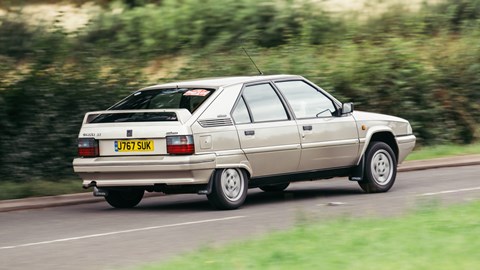
And yet the BX doesn’t fall apart in bends, either. A dab of the incredibly short-travel brake pedal instantly recalibrates my brain to old-school Citroen brakes – my first car was a GSA after all – while clever front suspension geometry ensures dive is pleasingly absent. Tip it into a corner and the steering that felt heavy at low speeds gains an ideal weight and streams the kind of information to your fingertips that most modern EPAS systems couldn’t even comprehend.
Shockingly there’s not a huge amount of roll, and there’s plenty of grip on the GTi spec wheel and tyre combination. As my confidence builds, I’m letting the perky engine rev out and carrying decent speed through bends with a flow that’s only punctuated by the creaking dashboard and occasional thump over surface imperfections. No wonder my parents had such a long BX addiction, one that I could very easily start myself.
Not that everyone was as sold on the BX at launch. With the dawn of the 80s came a fresh focus on aerodynamics, with Ford releasing the Sierra just days before the BX. Not only was the Sierra more slippery than the BX, at launch Citroen only offered elderly 1.4-litre and freshly developed 1.6-litre petrol engines that looked rather small compared to rivals.
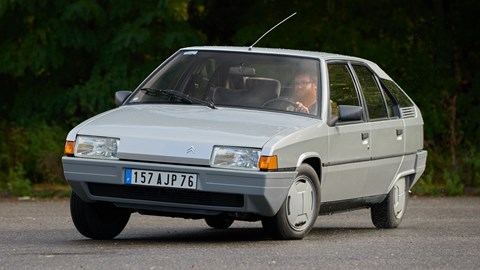
However, it wouldn’t be long before the range expanded to include an estate and more engines. First came a 1.9-litre non-turbocharged diesel engine that easily bettered the Sierra’s 2.3-litre lump, while a petrol-fired 1.9 followed with over 100bhp. Europe also got a 124bhp twin-carb Sport model tweaked by French tuning house Danielson easily spotted thanks to distinctive alloy wheels, a hooped spoiler and wider tracks with flared arches.
Not that this was the wildest BX available. Citroen had some success in the smaller engine classes of Group B with its four-wheel drive Visa Mille Pistes, so why not take aim at the turbocharged terrors dominating the top of the leaderboard? Various bonkers versions of the Visa were created including a mid-engined effort from Lotus, before development turned to the BX.
Two-wheel drive was trialled in 1983 before team chief Guy Verrier decided four-wheel drive was needed to take on the Quattro. Like that car Verrier wanted a direct link to the roadgoing BX, keeping a monocoque construction, hydropnuematic suspension and as many parts-bin pieces he could find. They included the Citroen SM’s five-speed gearbox, Peugeot 505’s rear axle and the engine from a Chrysler 180.
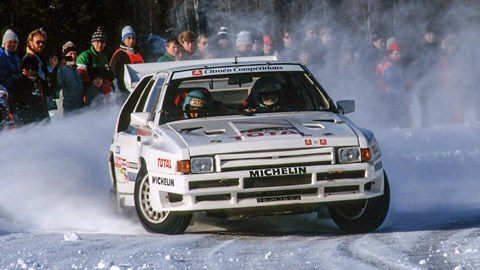
This old-school eight-valve engine was given a turbocharger and then placed longitudinally ahead of the front axle line, something Audi was already finding sub-optimal by the time the BX 4TC hit special stages in 1986. The resultant bitsa was heavy, underpowered and not at all reliable. With Citroen struggling to sell roadgoing versions, it was pulled from competition just before Group B got banned, and as many road cars as possible were bought back and crushed. All in all, it was an embarrassing failure, although things were looking up for the BX.
1986 marked a facelift for the regular models. The changes were minor on the outside with new larger indicators, beefier looking front wings and reshaped bumpers, but the controversial dashboard was replaced by something far more conventional. Regular dials replaced the bathroom scales found in most models and there were regular indicator stalks.
So far so boring, but fuel injection was also introduced for the first time. The change from GT to GTi pushed power up to 120bhp, not quite as much as the Peugeot 205 GTi, but still enough for a 0-62mph time that started with an eight.
As enticing a badge GTi was, there was another that was becoming increasingly tantalising; 16v. With four-valve heads developed from those fitted to the 205 T16 rally car and a range of lighter metals in its construction, the 1.9-litre engine was now capable of 158bhp and would rev beyond 7000rpm. Despite a relatively luxurious interior it still weighed less than 1100kg giving a brisk 0-62mph time of around 7.5 seconds.
The real key to the BX’s success was 1988’s introduction of a turbocharged 1.8-litre diesel engine with 89bhp. That was enough to give petrol-like acceleration with the kind of economy that would get fleet managers giddy. All that low-down torque and self-levelling suspension made it an ideal towcar as multiple awards in period proved.
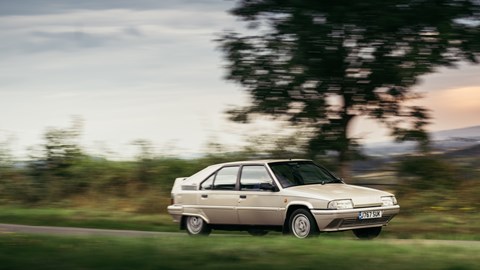
The refinements continued into the 90s, although even the introduction of four-wheel drive variants and slightly modernised styling couldn’t stop it looking rather long in the tooth compared to newer rivals. The introduction of the more conventional Xantia in 1993 saw the ending of BX hatch production, with the estate dying a year later.
While it could be argued that Citroens only got more ‘normal’ from this point on, especially given the death of hydropneumatic suspension, cars like the genre-busting C5-X and Ami quadricycle show there’s still some of the BX’s adventurous spirit in the company. We wouldn’t want it any other way.